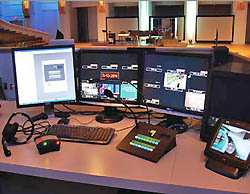
In addition, this system offers text messaging from a keypad loudspeaker station to any other user(s).
In working with digital intercom systems, it’s useful to have a solid understanding of audio and signal flow as well as good working knowledge of networking, telephony and VoIP (Voice over Internet Protocol).
The key to successfully setting up a system is to have a clear plan as to how the system is to be implemented (i.e., using existing wiring, using a facility’s structured cabling, establishing new cabling, and so on).
Further, there needs to be a thorough understanding of any additional connections (like connecting an existing legacy 2-channel partyline system or connecting in a remote location) that need to be made.
Really, though, many of the same principles for designing and implementing a legacy system apply to designing and setting up a digital one.
Here’s a glossary of terms it’s good to be familiar with when working with digital intercom systems:
DTMF – Dual-Tone Multi-Frequency signaling, used for telecommunication signaling over telephone lines in the voice-frequency band between telephone handsets and other communications devices and the switching center.
MADI – Multichannel Audio Digital Interface, an industry-standard electronic communications protocol that defines the data format and electrical characteristics of an interface carrying multiple channels of digital audio.
SIP – Session Initiation Protocol, a signaling protocol widely used for controlling multimedia communication sessions such as voice and video calls over Internet Protocol (IP).
TCP/IP – Internet Protocol Suite, the set of communications protocols used for the Internet and other similar networks
AES3 – The digital audio standard frequently called AES/EBU used for carrying digital audio signals between various devices.
Star Topology – In its simplest form, a star network consists of one central switch, hub or computer, which acts as a conduit to transmit messages. Thus, the hub and leaf nodes, and the transmission lines between them, form a graph with the topology of a star.
Daisy Chain – Connecting each device in series to the next. If a message is intended for a device partway down the line, each system bounces it along in sequence until it reaches the destination.
